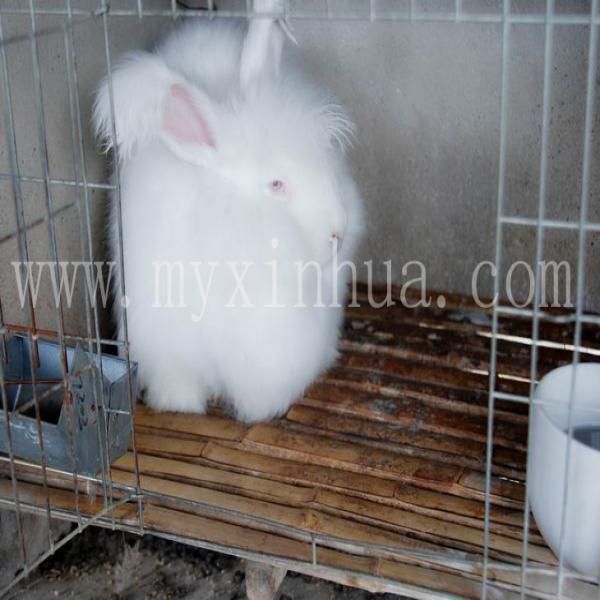

长毛兔具有发达的消化系统的特点
 发布日期:2024-01-13
来源:http://www.myxinhua.com 发布人:创始人
发布日期:2024-01-13
来源:http://www.myxinhua.com 发布人:创始人
对粗纤维的消化率较高:长毛兔属单胃草食动物,消化道长而复杂,容积很大,依靠盲肠中的微生物和发达的球囊组织,能有效地利用低质高纤维饲料。据试验,在长毛兔日粮中供 给适量的粗纤维饲料,对长毛兔的健康是有益无害的,可刺激肠道蠕动,促进正常的消化、吸收功能。相反,如果日粮中粗纤维含量过低,则可引起肠道蠕动减慢,内容物滞留时间延长,发酵变质,诱发有害细菌大量繁殖,引起肠炎、腹泻,甚死亡。
The digestion rate of crude fiber is relatively high: Long haired rabbits belong to monogastric herbivores, with a long and complex digestive tract and a large volume. They rely on the microorganisms in the cecum and developed balloon tissue to effectively utilize low-quality and high fiber feed. According to experiments, providing an appropriate amount of coarse fiber feed in the diet of long haired rabbits is beneficial and harmless to their health, can stimulate intestinal peristalsis, and promote normal digestion and absorption functions. On the contrary, if the crude fiber content in the diet is too low, it can cause slow intestinal peristalsis, prolonged retention time of contents, fermentation and spoilage, induce the proliferation of harmful bacteria, cause enteritis, diarrhea, and even death.
能充分利用粗饲料中的蛋白质:据试验,长毛兔不仅对青粗饲料中的蛋白质有较高的消化率,而且对低质饲料中的蛋白质有很强的消化利用能力。

Being able to fully utilize the protein in roughage: According to experiments, long haired rabbits not only have a high digestion rate for protein in green roughage, but also have strong digestion and utilization ability for protein in low-quality feed.
能耐受口粮中的高钙比例:长毛兔对日粮中的钙、磷比例要求不像其他畜禽那样严格。试验表明,长毛兔日粮中的含磷请不宜过高,只有钙、磷比例为2:1以下时,才能忍受高水平磷,过量的磷由粪尿排出体外。日粮中含磷量过髙(超过1%时),还会降低饲料的适口性,影响长毛兔的采食量。
Can tolerate high calcium ratios in the diet: Long haired rabbits do not have as strict requirements for calcium and phosphorus ratios in the diet as other livestock and poultry. Experiments have shown that the phosphorus content in the diet of long haired rabbits should not be too high. Only when the ratio of calcium to phosphorus is below 2:1 can high levels of phosphorus be tolerated, and excessive phosphorus is excreted from the body through feces and urine. If the phosphorus content in the diet is too high (exceeding 1%), it will also reduce the palatability of the feed and affect the feed intake of long haired rabbits.
兔毛有一定的生长期,当兔毛生长到成熟末期,毛根底部逐渐变细而脱落,新毛开始生长,这种换毛过程称为兔毛的脱换,年龄性换毛:年龄性换毛指幼兔而言。仔兔初生时无毛,一般在45日龄开始长出细毛,到30日龄左右乳毛全部长成。生长发育正常的幼兔,次年龄性换毛是在30100日龄,第二次年龄性换毛是在130190日龄。在6.57.5月龄以后的换毛规律与成年兔一样。
Rabbit hair has a certain growth period. When rabbit hair grows to the end of maturity, the bottom of the hair roots gradually becomes thinner and falls off, and new hair begins to grow. This process of hair exchange is called rabbit hair exchange. Age related hair exchange refers to young rabbits. When a young rabbit is born, it is hairless and usually begins to grow fine hair at 45 days of age. By around 30 days of age, all the milk hair has grown. For young rabbits with normal growth and development, the first age related hair change is at 30100 days old, and the second age related hair change is at 130190 days old. The hair changing pattern after 6.57.5 months of age is the same as that of adult rabbits.
季节性换毛:季节性换毛指成年兔而言。在正常情况下,成年兔每年春秋两季各换毛1次。春季换毛在34月份进行,由于此时饲料丰富,代谢旺盛,所以兔毛生长较快,换毛期较短;秋季换毛在89月份进行,由于饲料变换,毛囊代谢功能减弱,所以兔毛生长较慢,换毛期较长。病理性换毛:长毛兔患病期间或较长时间内营养不足,新陈代谢紊乱,皮肤代谢失调,往往会发生全身性或局部性的脱毛现象,即为病理性换毛。
Seasonal shedding: Seasonal shedding refers to adult rabbits. Under normal circumstances, adult rabbits change their fur once a year in spring and autumn. Spring hair changing takes place in April. Due to the abundant feed and vigorous metabolism at this time, rabbit hair grows faster and the hair changing period is shorter; Autumn hair changing takes place in August. Due to changes in feed, the metabolic function of hair follicles is weakened, resulting in slower growth of rabbit hair and a longer hair changing period. Pathological hair loss: During or for a long period of time, long haired rabbits suffer from malnutrition, metabolic disorders, and skin metabolic disorders, often leading to systemic or local hair loss, which is known as pathological hair loss.